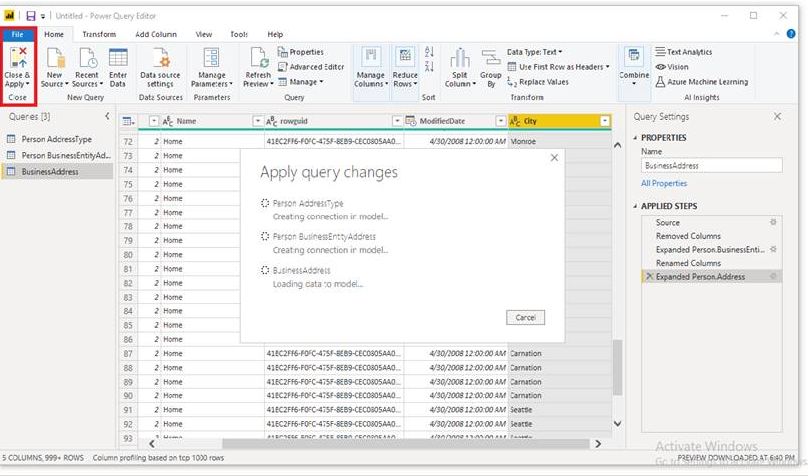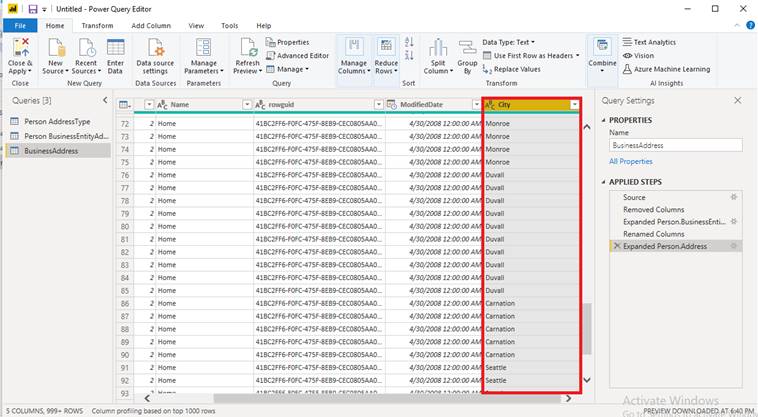03 October 2019
How do you combine / append / stack tables with Power BI / Power Query? There are multiple ways to accomplish this, but we're going to start with the basics. Scenario: Combine Data from 2 CSV files. Imagine that we have 2 CSV files. Sales data for the year 2017; Sales data for the year 2018; In reality, our data sources can be any. Power query Merge two tables with filter. Everything you need to know about Power BI: news, resources, and a community of super users ready to answer questions! 0 votes n Power BI Desktop you can join two tables with Merge menu item in the Query Editor, in Home tab, Under Combine, Merge Queries. The Merge Window will appear with ability to select first table (Left part of the join), and the second table (Right part of the join). Answered Dec 16, 2020 by Gitika. Table.Combine(tables as list, optional columns as any) as table About. Returns a table that is the result of merging a list of tables, tables. The resulting table will have a row type structure defined by columns or by a union of the input types if columns is not specified. Merge the three tables together. Learn how to quickly merge and append tables using the query editior in Power BI. Build models with multiple data sources.Contact me on LinkedIn:www.linkedin.
Power BI dataflows is a powerful self-service ETL tool. However, some features demand the use of Power BI Premium, way more expensive than the PRO version and sometimes inaccessible.
One of these tasks, for example, is the merge of two tables. Even in the same dataflow, if you have two tables and make the merge, the resulting table will be a calculated table and this requires Power BI Premium for the refresh.
We could argue the data should be better prepared in Data Warehouse, but this is not always true. The merge of two tables is a so simple task that even having a good DW as a source you may need it.
Let's say we have two tables, Customers and Geography. Customers table has a GeographyId field which identifies the location of the client.
In order to make the merge between Customers and Geography we need to follow these steps:
- Edit the query for the DimCustomer table
- Click on the ‘…' button, 'Combine Tables' menu option, 'Merge Queries'
- In the Merge window that will be opened, select the 2nd table as DimGeography
- Again in the Merge window, select GeographyId field in the DimCustomer table
- One more time, in the Merge window, select GeographyId field in the DimGeography table

- After the Merge window updates itself, click Ok button
- In the DimCustomer table, find the DimGeography field and click the expand button
- Select the fields you would like to include in the DimCustomers table and click the Ok button
Merge Two Tables Power Bi
- Close and save the query
Making the merge between Customers and Geography will turn Power BI Premium into a requirement to refresh the dataflow.
In order to work around this problem, there is a simple solution: we can edit the query again, right-click the table Geography and disable the load option.
When this option is disabled, the merge is not considered as a calculated table, allowing the refresh with a Power BI Pro account, no need for Power BI Premium. Another result is that we will not see the Geography table available in the dataflow anymore, only the Customers table.
How To Merge Tables In Power Bi
-->A merge queries operation joins two existing tables together based on matching values from one or multiple columns. You can choose to use different types of joins, depending on the output you want.
Merging queries

- After the Merge window updates itself, click Ok button
- In the DimCustomer table, find the DimGeography field and click the expand button
- Select the fields you would like to include in the DimCustomers table and click the Ok button
Merge Two Tables Power Bi
- Close and save the query
Making the merge between Customers and Geography will turn Power BI Premium into a requirement to refresh the dataflow.
In order to work around this problem, there is a simple solution: we can edit the query again, right-click the table Geography and disable the load option.
When this option is disabled, the merge is not considered as a calculated table, allowing the refresh with a Power BI Pro account, no need for Power BI Premium. Another result is that we will not see the Geography table available in the dataflow anymore, only the Customers table.
How To Merge Tables In Power Bi
-->A merge queries operation joins two existing tables together based on matching values from one or multiple columns. You can choose to use different types of joins, depending on the output you want.
Merging queries
You can find the Merge queries command on the Home tab, in the Combine group. From the drop-down menu, you'll see two options:
- Merge queries: Displays the Merge dialog box, with the selected query as the left table of the merge operation.
- Merge queries as new: Displays the Merge dialog box without any preselected tables for the merge operation.
Identify tables for merging
The merge operation requires two tables:
- Left table for merge: The first selection, from top to bottom of your screen.
- Right table for merge: The second selection, from top to bottom of your screen.
Note New world discord.
The position—left or right—of the tables becomes very important when you select the correct join kind to use.
Select column pairs
After you've selected both the left and right tables, you can select the columns that drive the join between the tables. In the example below, there are two tables:
- Sales: The CountryID field is a key or an identifier from the Countries table.
- Countries: This table contains the CountryID and the name of the country.
Append Two Tables Power Bi
Merge dialog box with the Left table for merge set to Sales and the CountryID column selected, and the Right table for merge set to Countries and the CountryID column selected.
The goal is to join these tables by using the CountryID column from both tables, so you select the CountryID column from each table. After you make the selections, a message appears with an estimated number of matches at the bottom of the dialog box.
Note
Although this example shows the same column header for both tables, this isn't a requirement for the merge operation. Column headers don't need to match between tables. However, it's important to note that the columns must be of the same data type, otherwise the merge operation might not yield correct results.
You can also select multiple columns to perform the join by selecting Ctrl as you select the columns. When you do so, the order in which the columns were selected is displayed in small numbers next to the column headings, starting with 1.
For this example, you have the Sales and Countries tables. Each of the tables has CountryID and StateID columns, which you need to pair for the join between both columns.
First select the CountryID column in the Sales table, select Ctrl, and then select the StateID column. (This will show the small numbers in the column headings.) Next, perform the same selections in the Countries table. The following image shows the result of selecting those columns.

